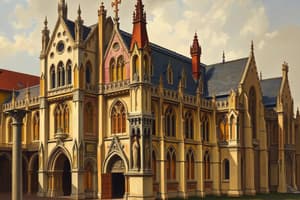Podcast
Questions and Answers
What architectural style marks the beginning of Medieval architecture in Europe?
What architectural style marks the beginning of Medieval architecture in Europe?
- Neoclassical Architecture
- Baroque Architecture
- Romanesque Architecture (correct)
- Renaissance Architecture
What is a primary feature of the Motte and Bailey castle design?
What is a primary feature of the Motte and Bailey castle design?
- Multiple rings of defensive walls
- An open courtyard surrounded by a defensive ditch (correct)
- Circular towers with open courtyards
- A fortified tower standing alone
What characteristic is typical of castles built during the 11th and 12th centuries in England?
What characteristic is typical of castles built during the 11th and 12th centuries in England?
- Large windows and thin walls
- Complex rooftop gardens
- Thick walls and small windows (correct)
- Use of entirely wooden structures
Which type of castle is known for its multiple rings of walls and courtyards?
Which type of castle is known for its multiple rings of walls and courtyards?
What was a common characteristic of everyday buildings in Medieval Europe?
What was a common characteristic of everyday buildings in Medieval Europe?
What architectural feature characterizes the Early English or Lancet Period?
What architectural feature characterizes the Early English or Lancet Period?
Which period emphasizes ornate decoration and includes flowing tracery?
Which period emphasizes ornate decoration and includes flowing tracery?
What is a notable architectural feature of the Perpendicular Period?
What is a notable architectural feature of the Perpendicular Period?
During which period are square-headed mullion windows predominantly used?
During which period are square-headed mullion windows predominantly used?
Which period is marked by less massive structures and simpler ornamentation?
Which period is marked by less massive structures and simpler ornamentation?
What is the primary purpose of a donjon in a medieval castle?
What is the primary purpose of a donjon in a medieval castle?
Which feature is specifically designed for lookout or defense at the top of a castle tower?
Which feature is specifically designed for lookout or defense at the top of a castle tower?
What is machicolation used for in a castle?
What is machicolation used for in a castle?
Which component of a castle is primarily designed to block an entrance?
Which component of a castle is primarily designed to block an entrance?
What are crenels in a battlement?
What are crenels in a battlement?
What is the main function of a portcullis in a castle?
What is the main function of a portcullis in a castle?
Which of these terms refers to the protective outer wall encircling a castle?
Which of these terms refers to the protective outer wall encircling a castle?
What is a main function of the gatehouse in a medieval castle?
What is a main function of the gatehouse in a medieval castle?
Flashcards are hidden until you start studying
Study Notes
Overview of Medieval Architecture
- Emphasizes architectural styles from the Middle Ages in Europe, including Romanesque and Gothic designs.
Medieval Houses
- Built from locally available materials; early designs often consisted of two rooms.
- Typically had one room for the owner and another for animals.
Castles in Medieval Europe
- Approximately 1500 castles constructed in England during the 11th and 12th centuries.
- Castles featured thick walls and small windows, serving as both residences and fortifications.
Types of Castles
- Motte and Bailey: Comprises an open courtyard (motte) and a surrounding defensive ditch (bailey), often filled with water.
- Stone Keep Castle: Central fortified tower serving as a key feature within a castle complex.
- Concentric Castle: Features multiple rings of walls and courtyards for enhanced defense against sieges.
Parts of Castles
- Donjon/Keep/Tower: Stronghold acting as a refuge during attacks.
- Peel: A low fortified emergency defense tower.
- Bartizan: Overhanging turret used for lookout and defense.
- Machicolation: Openings in parapets to drop projectiles on attackers.
- Battlement: Wall with gaps for discharging arrows; includes merlons and crenels.
- Portcullis: A heavy barrier that could be lowered to secure entrances.
- Drawbridge: Platform spanning a moat, raised to block entry.
Outer Structure
- Outer Curtain Wall: Thick stone walls protecting the entire castle complex.
- Gatehouse: Main, fortified entrance with drawbridge and portcullis.
Periods of Development in Medieval Architecture
- Anglo-Saxon Period: Characterized by timber usage for domestic buildings.
- Norman or Transition Period: Known for bold architecture, distinct piers, and flat buttresses.
- Early English or Lancet Period: Features tall, narrow lancet windows and steep roofs.
- Decorated or Geometrical & Curvilinear Period: More ornate decoration with geometric tracery.
- Perpendicular Period: Recognized for fan vaulting and rectilinear designs.
- Tudor Period: Commonly seen in domestic architecture, characterized by square-headed windows and ornate features.
Notable Castles
- Carcassonne: Citadel in France, known for its fortifications.
- Castillo de Coca: Castle in Spain displaying Spanish Gothic architecture.
- Windsor Castle: One of the oldest inhabited castles in the world.
- Warwick Castle: Iconic medieval castle in England.
- Bodiam Castle: Picturesque 14th-century moated castle.
- Edinburgh Castle: Historic castle located on Castle Rock in Scotland.
- Tower of London: Famous castle and former royal palace, known for its history and architecture.
Studying That Suits You
Use AI to generate personalized quizzes and flashcards to suit your learning preferences.




